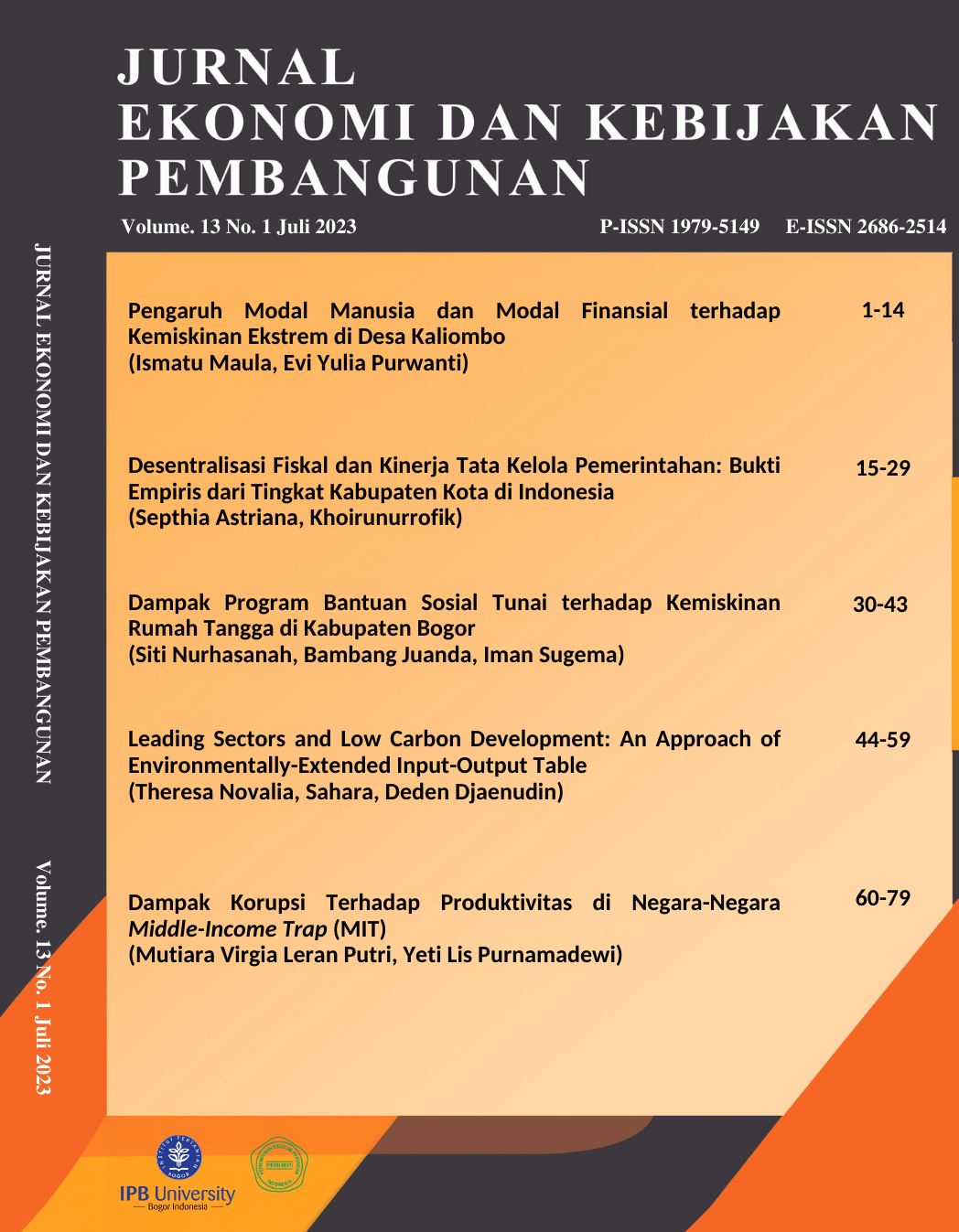Leading Sectors and Low Carbon Development: An Approach of Environmentally-Extended Input-Output Table BPS, IPB University
Abstract
Climate change issues have become a consideration in Indonesia due to the trade-off between economic development and environmental conservation. However, studies that incorporate environmental aspects into economic models are still limited. This study aims to develop the Environmentally-Extended Input-Output Table (EE-IOT) and determine the leading sectors in the Indonesian economy by considering greenhouse gas emissions as environmental pressures. EE-IOT is built in the form of Single-Region I-O. The result shows that the most direct CO2 emissions are produced by productive sectors and the rest from household consumption. Based on the leading sector analysis, the manufacturing of Food and Beverages Products is the leading sector with low CO2 emissions. Moreover, the sector with the highest output multiplier and relatively low CO2 multiplier is Food and Beverage Services. Meanwhile, Animal Productions has the lowest CO2 multiplier and high output multiplier. However, the development of these leading sectors cannot stand alone because it will have linkages with other sectors regarding inputs and outputs. After all, these supporting sectors will produce CO2 emissions as well. Therefore, with a low-emission approach, the government needs additional efforts to encourage these supporting sectors, such as energy, transportation, agriculture, and forestry.
References
———. 2019. Pembangunan Rendah Karbon: Pergeseran Paradigma Menuju Ekonomi Hijau Di Indonesia. Jakarta: Badan Perencanaan Pembangunan Nasional.
———. 2021. “Ringkasan Eksekutif Kebijakan Pembangunan Berketahanan Iklim (Climate Resilience Development Policy) 2020–2045.” Jakarta: Badan Perencanaan Pembangunan Nasional. https://lcdi-indonesia.id/wp-content/uploads/2021/04/Buku-0_Ringkasan-Eksekutif-Dokumen-Kebijakan-Pembangunan-Berketahanan-Iklim.pdf.
BNPB. 2022. “Data Bencana Indonesia 2021.” Vol. 1. Jakarta.
Boslaugh, Sarah. 2007. “An Introduction to Secondary Data Analysis.” Secondary Data Sources for Public Health: A Practical Guide.
BPS. 2021a. Indikator Tujuan Pembangunan Berkelanjutan (TPB) Indonesia 2021. Jakarta: Badan Pusat Statistik.
———. 2021b. Tabel Input-Output Indonesia 2016. Jakarta: Badan Pusat Statistik.
Brown, Nils, Mårten Berglund, Mia Bivered, Malcolm Gray, and Shinichiro Nakamura. 2021. Producing Environmental Accounts with Environmentally Extended Input-Output Analysis. Luxembourg: Publications Office of the European Union.
Eurostat. 2015. Manual for Air Emissions Accounts. Luxembourg: Publications Office of the European Union.
IPCC. 2014. Climate Change 2014: Synthesis Report. Geneva: Intergovernmental Panel on Climate Change.
Kemenkeu. 2021a. “Menkeu: Perubahan Iklim Menjadi Isu Utama Pembahasan Global.” 2021. https://www.kemenkeu.go.id/publikasi/berita/menkeu-perubahan-iklim-menjadi-isu-utama-pembahasan-global/.
———. 2021b. “Menkeu Serukan Dorongan Realisasi Pendanaan Iklim Untuk Negara Berkembang Dalam Pertemuan COP26.” 2021. https://www.kemenkeu.go.id/media/18768/sp-91-menkeu-serukan-dorongan-realisasi-pendanaan-iklim-untuk-negara-berkembang-dalam-pertemuan-cop26.pdf.
KLHK. 2021. Laporan Inventarisasi Gas Rumah Kaca Dan Monitoring, Pelaporan, Dan Verifikasi Tahun 2020. Jakarta: Kementerian Lingkungan Hidup dan Kehutanan. http://ditjenppi.menlhk.go.id/reddplus/images/adminppi/dokumen/igrk/LAP_igrk2020.pdf.
LCDI. 2021. “Mengatasi Pandemi COVID-19 Dan Krisis Iklim Dengan Pembangunan Rendah Karbon.” 2021. https://lcdi-indonesia.id/2021/09/10/mengatasi-pandemi-covid-19-dan-krisis-iklim-dengan-pembangunan-rendah-karbon/.
Leontief, Wassily. 1970. “Environmental Repercussions And The Economic Structure: An Input-Output Approach.” The Review of Economics and Statistic 52 (3): 2622–271. https://doi.org/10.4324/9781315197715-18.
Li, Xiaoyan. 2021. “Study on the Impact of Energy Rebound Effect on Carbon Emission Reduction at Different Stages of Urbanization in China.” Ecological Indicators 120 (January): 106983. https://doi.org/10.1016/J.ECOLIND.2020.106983.
Miller, Ronald E., and Peter D. Blair. 2009. Input-Output Analysis: Foundation and Extension, Second Edition. New York: Cambridge University Press. https://doi.org/10.4324/9780203962404-12.
Ojha, Vijay P., Sanjib Pohit, and Joydeep Ghosh. 2020. “Recycling Carbon Tax for Inclusive Green Growth: A CGE Analysis of India.” Energy Policy 144. https://doi.org/10.1016/j.enpol.2020.111708.
Othman, Jamal, and Yaghoob Jafari. 2016. “Identification of the Key Sectors That Produce CO2 Emissions in Malaysia: Application of Input–Output Analysis.” Carbon Management 7: 113–24. https://doi.org/10.1080/17583004.2016.1178451.
Panayotou, Theodore. 1993. Empirical Tests and Policy Analysis of Environmental Degradation at Different Stages of Economic Development. Geneva: International Labour Office.
Reyes, Rachel C. 2009. “Input Output Analysis of Key Sectors in Philippine Carbon Dioxide Emissions from A Production Perspective.” DLSU Business and Economics Review 19: 1–16. https://doi.org/10.3860/ber.v19i1.1109.
Tukker, Arnold, Gjalt Huppes, Laura Van Oers, and Reinout Heijungs. 2006. Technical Report Series: Environmentally Extended Input-Output Tables and Models for Europe. Spain: European Commission.
UN. 2018. Handbook on Supply, Use and Input-Output Tables with Extensions and Applications. New York: United Nations.
———. 2020. Natural Capital Accounting for Integrated Climate Change Policies. New York: United Nations. https://doi.org/10.18356/9789210052535.
UN, EU, FAO, IMF, OECD, and WB. 2014. System of Environmental-Economic Accounting 2012 – Central Framework. New York: United Nations.
UN, EU, FAO, OECD, and WB. 2017. “System of Environmental-Economic Accounting 2012 – Applications and Extensions.” New York: United Nations. https://seea.un.org/sites/seea.un.org/files/ae_final_en.pdf.
UN, WB, EU, IMF, and OECD. 2009. System of National Accounts 2008. New York: United Nations. https://doi.org/10.1515/9783110605914-007.
Widiawati, Yeni, and Muhammad N. Rofiq. 2019. “Akurasi Inventori Gas Rumah Kaca Dari Peternakan Menggunakan Lokal Faktor Emisi: Tier 2.” In Emisi Gas Rumah Kaca Dari Peternakan Di Indonesia Dengan Tier 2 IPCC, edited by Edvin Aldrian, Suharyono Puspowardoyo, and Budi Haryanto. Jakarta: LIPI Press.
Yusuf, Arief A., and Budy P. Resosudarmo. 2015. “On the Distributional Impact of a Carbon Tax in Developing Countries: The Case of Indonesia.” Environmental Economics and Policy Studies 17 (1): 131–56. https://doi.org/10.1007/s10018-014-0093-y.
Authors

This work is licensed under a Creative Commons Attribution-NonCommercial 4.0 International License.
The authors who publis article(s) in Jurnal Ekonomi and Kebijakan Pembangunan have to understand and agree that the copyright of article published is owned by Jurnal ekonomi and Kebijakan pembangunan including to reproduce, distribute and sell this journal to public.

